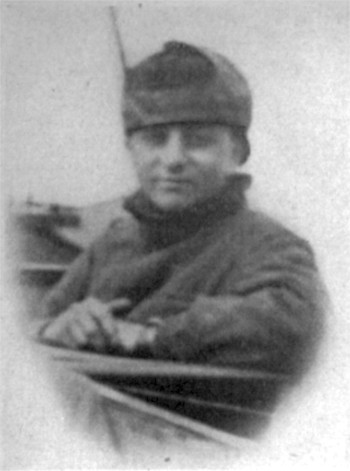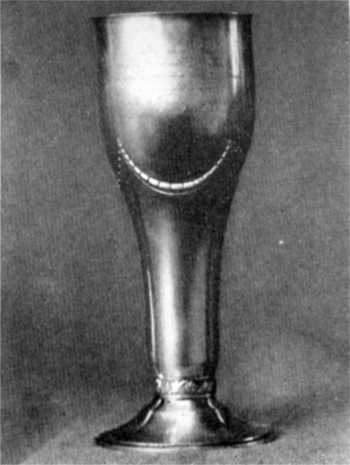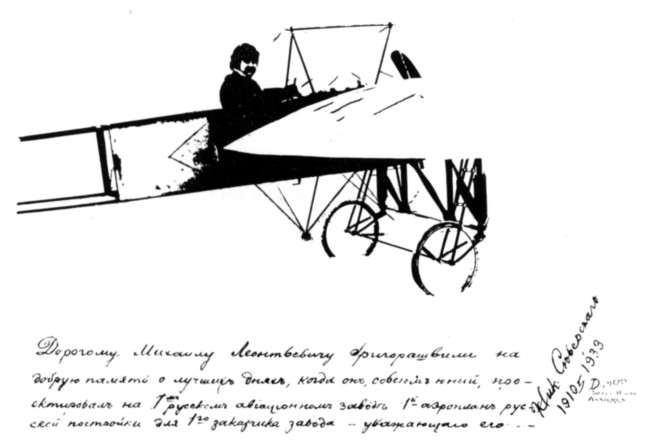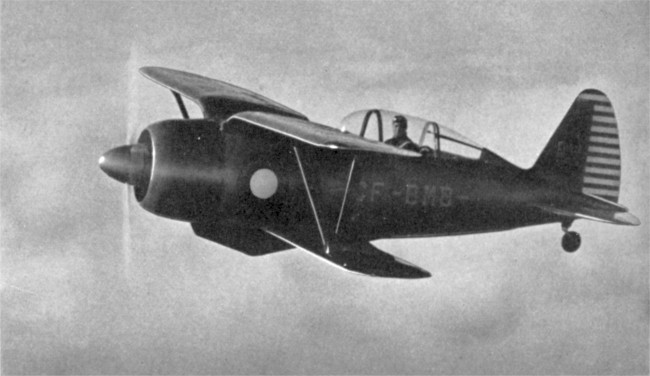Flying, As It Was – Early Days In Russia
By Michael Gregor
Editor's note: This page is adapted from an article in "The Sportsman Pilot" of 15 December 1939. Michael Gregor (1888–1953) was born Mikhail Leontyevich Grigorashvili (Михаил Леонтьевич Григорашвили). In 1921, he emigrated to the United States and took up citizenship in 1926. His first job was washing cars in a New York City garage. This job was of short duration, as was a job as mechanic with the U.S. Airmail service at Philadelphia. He got back to aviation for keeps with a job as engineer with Gallaudet at East Greenwich, RI. In 1921 he won an Army design contest for pursuit planes. A few months later he won another Army design contest for a night bomber. This design closely resembles bomber types just prior to the second World War. In Dayton, he prepared plans for the Army for a vertically rising airplane but no action was taken on the drawings. In 1927 he joined the Curtiss Company at Garden City, then as a consulting engineer he designed the famous Bird biplanes. In 1931 he supervised the design and construction of the prototypes of the Seversky amphibian and land planes and in 1937 designed the single seat fighter for the Canadian Car & Foundry Company.
He demonstrates a superb sense of humour over his early exploits, but continued in Canada and the USA as an aeronautical engineer of talent. The Canadian Car & Foundry FDB-1 illustrated below was designed by Michael Gregor, and while it is not mentioned in the author's account, we must surmise that it was used as a suitable "promotion" at the time of this article being published.

My interest in aviation has overshadowed successes in other engineering fields because of the inspiration supplied by my father when I was eight years old. It was in 1896 that my father took me to see a demonstration of hot air ballooning in Russia. This made a great impression upon me, and that evening I was full of questions about aeronautics and the future use of lighter-than-air craft. I shall never forget the principal comment he made. He pointed out that such flights as we had seen that day had no practical application then, nor would that type of aeronautics amount to anything in the future.
“But,” he told me, “there are a few men in the world today, such as Octave Chanute, Hiram Maxim, Clement Ader and Otto Lilienthal, who are working on a mechanical solution of the problem of flight, a solution that is based on the principle of bird flight. When such a mechanical bird is created, then a great achievement will be made and man will master the air.” Seven years later, 36 years ago this December 17, the Wright brothers at Kitty Hawk provided the solution.
Like any other boy I had been dreaming about my future life as a grown man, At that time the height of my ambition had been to become a stable master. However, this conversation with my father changed that and I decided to devote my life to the progress of mechanical flight.
In high school and college I took the type of courses that would fit me for participation in aeronautics and in 1907, while in college, I organized a group of fellow students for the purpose of studying aviation. Between 1907 and 1909 this group held meetings and published several issues of a periodical named the “Aeromobile,” of which I was editor. This consisted of reports by students and professors on phases of aeronautics based on information received from various parts of Europe. It was issued only as sufficient material for it accumulated.
In 1910 an organization known as the First Russian Aircraft Corporation was formed for manufacturing purposes. I was engaged as a designer and thus started a career in aeronautical engineering that continues to this day. We had no wind tunnels to guide us in our calculations. We had no drawings. Our chief inspiration was a set of photographs of Bleriot airplanes that had been sent to us by a friend who corresponded from France.
With the aid of these photographs and the data that had been assimilated from newspaper and magazine reports we designed and built the Russia B. It was the first airplane to be built and flown in that country. It naturally followed the Bleriot lines, though we did introduce many variations. One of these was the substitution of a tail skid for the Bleriot type swivelling tailwheel. This tailwheel wasn’t very successful, anyway, for the Bleriot was a hard ship to handle and the wheel aggravated a pronounced ground looping tendency. It seemed to us that the skid would give better directional control in landings and take-offs, serving also as a brake in the case of the former.

The plane flew successfully on its first flight on August 26, 1910, with Matievich-Mazievich at the controls. He had just returned to Russia after training in France, where he had been sent to become a military pilot. He was practically commandeered for this test flight of our new airplane.
It was a good ship for that day right from the start. In fact, this also was the first privately owned airplane in Russia, for it was sold to Mr. N. Seversky, a popular Russian musical comedy star, and father of the well-known Russian-American pilot. The elder Seversky flew the ship on local hops as a sport.
The Russia B was a one-place monoplane powered by the Anzani 25. It was very strongly built, and served well for two years. It was retired to ground duty only when it wouldn’t fly—because its original weight had been increased through absorption of moisture, because the engine had lost some power through use, and possibly because of minor changes in the structure incident to maintenance.
It was still going strong as late as 1917, however, as a “grass-cutter” for student training. As a training device it was subjected to hard usage, demonstrating the ruggedness of the original construction.
Incidentally, it was not at all uncommon in those days for a plane to reach the stage where it would no longer fly, for such reasons as mentioned above. The margin between flying speed and top speed was so slight that many minor factors could contribute to make it unable to go aloft.
Flying interest was growing and, as happened in so many places, a group with the means and the sporting instinct was formed to engage in the new activity. I had become interested in the Imperial Russian Air Club when it was organized in 1909 because the group included a technical committee that was headed by a former professor, N. N. Mitinsky, a man whose intellect made him outstanding in many fields besides the aeronautical. I was a great admirer of his and became a member of that committee.
When it was decided to purchase an airplane in France for the club members to train on and fly for sport I was delegated to make the trip, master the airplane and deliver it back to Russia. This seemed like my golden opportunity, and it was with great anticipation that I set off for France.
Disillusions came thick and fast, however. The plane selected by the club was a two-place, side-by-side monoplane manufactured by Pishoff, an Austrian who maintained “manufacturing” establishments in Vienna and Paris. I reported at Paris, and was quickly warned by various pilots to have nothing to do with Pishoff machines.
I soon found out why. The Pishoff was such a peculiar machine that it has always seemed to me that it must have been built to teach us how not to build an airplane.
Ahead of, and below, the single high wing was an enclosed fuselage with the two seats. It was similar to the interior of an automobile. The engine was in the nose, well-cowled. The propeller, however, was a pusher, mounted just aft the trailing edge of the wing. Power was transmitted through the crank shaft and an extension that ran between the two seats. A chain drive ran vertically to a short, horizontal shaft back of the trailing edge of the wing. This carried the thrust to the propeller.
The latter shaft was hollow so that the upper longeron in a triangular longeron system ran through it and the propeller hub. In other words, the prop revolved around the top longeron. The trailing edge of the cut was cut out so it would clear the revolving prop and there was a fair clearance between the tips of the blades and the two lower longerons.

It was practically impossible to adjust that chain drive so that there would be no vibrations. We might get it adjusted properly on the ground, but no matter what we did it would vibrate violently in the air. Naturally, severe vibrations eventually would break the chain, the chain would fly back and break the propeller, and the broken bits of propeller all too often would sever one of the longerons. The result is obvious. Of course, we had no parachutes to resort to when break-ups in the air occurred.
I had time to secure only one instruction flight before the above sequence occurred while my instructor, Pierre Landron, was flying solo. He was killed instantly. There was only one other living pilot left who had had experience on this ship – Pishoff himself. But, as he was in the hospital recovering from a trolley car accident, I was left to my own devices.
Taking special pains with the adjustment of the chain, I managed to make a few flights and then obtained FAI Certificate No. 577. With this I became the Pishoff instructor and chief test pilot! Warnings about flying the Pishoff machines continued, but I stuck it out for a couple of months. I reasoned that if I could fly that crate I would be able to handle most anything.
The machine we had bought for the Imperial Russian Air Club finally was shipped and I decided that I had had my share of luck with the Pishoff machines. So I returned to Russia. I was so fed up with the Pishoff plane by this time that I recommended it not be used as a student trainer. This created much feeling among the club members because of the investment involved. When it was flown solo some time later by A. Raesky, one of the club’s instructors, the machine crashed and the pilot was severely injured. During World War I Lebedeff, the chief club instructor, became the largest manufacturer of aircraft in Russia.
I discovered that the club had accumulated a Bleriot in the meantime, which was still stored in its original packing case. It had been ignored because that particular model had the reputation of not being able to take off. I secured permission to uncrate it, and, after tuning up the 25 horsepower Anzani, I managed to make a number of successful flights. This flying gave me valuable experience in making forced landings, as the engine usually quit after I had made half or one quarter circle around the field. Since only narrow “runways” had been cleared between bushes and ditches that dotted the field, these landings were quite tricky.
Because of the success that I had with this machine the club proposed that I give instruction under Lebedeff in the Club’s model IV Farman. This had no enclosed fuselage, and since I was unaccustomed to sitting out in the open, my first flight was not particularly pleasant or smoothly executed. When I landed I found a group gathered around my mother who had come to the field to watch me fly, and was told that she had fainted at the moment I had taken off.
Exhibition flights were catching the public fancy about this time and I wanted to cash in on my experience. I offered the club an arrangement by which I would be allowed to fly in exhibitions when not engaged in teaching. This was not taken up, so I looked for other fields to conquer.
It quickly developed that in Cheliabinsk, on the Siberian border, there was a Bleriot that the pilot had not been able to fly. There was great demand in that community for exhibition flights and much money already had been taken in. I received a bid to undertake to fly the Bleriot and thus began my barnstorming career. I fulfilled the engagement, being able to fly the Bleriot largely because I weighed much less than the pilot who had been thwarted in the original attempts.
I barnstormed all over Russia for about two years, and greatly enjoyed the experience. Many interesting incidents occurred, some amusing and others quite serious. One of the most amusing happened in Tomsk. The students there were so enthusiastic that they insisted in spite of my violent protests in carrying me to and from my airplane on their shoulders. This was really rough treatment.
In Rovno, Russian Poland, we were allowed the use of a large military field. It was so open, however, that the public could watch our activities without having to pay an admission fee to the observation area. There being no point to flying for nothing, we cast about for a better site and found a race track located in the midst of thick woods that prevented anyone from seeing the flying unless they paid to get into the grandstands along one side of the track.
While the spectator angle was satisfactory, the flying conditions were far from ideal. Before agreeing to attempt to fly from this site I made one test take-off and landing, using, of course, the infield of the track, I got away with it all right, missing the high trees by a fair margin, because the wind was in just the right direction. The exhibition was scheduled and advertised and the crowds arrived. When the time for the show came, however, the wind was across the narrow part of the infield.
Nevertheless, I tried to get into the air. Because of engine trouble I was unable to clear the trees on the first official take-off, and crashed to the ground, with considerable damage to the machine. I had no parts and so had to make all the repairs and replacements the best I could, even to the construction of a new propeller. The latter was good enough to become the basis of a propeller business several years later.

Then, for the first time, I noticed a complete disagreement between the thoughts of the pilot in a crack-up and those of the observing public. When I pulled myself out of the debris of the crack-up my first thoughts were: “There is my pal, all washed out.” In the meantime, the crowd having broken the fences, ran up to me with wide open eyes and nervously shouted at me: “Aren’t you hurt?” to which my answer was: “Me? Of course not, but look at the airplane!”
I made another attempt after the machine was in flying condition, and this time a tire blew out. I was making a fast repair to the tires when the impatience of the crowd began to cause the police considerable concern. I was told that the spectators believed the whole thing was a fake and that I had better take off or there would be trouble. The police claimed that they could no longer control the more aggressive elements of the mob, and cancelled the exhibition without my consent.
I had been anxious to make good on the program but because of the taunts I became angry and strode away from the machine toward the woods. This effort to get away made the crowd more angry. Several hundred persons followed me through the woods out onto the open plain. Finally, the remarks bothered me so much I turned around and dared the person or persons responsible to face me.
No one moved, so I drew my revolver and threatened to shoot into the crowd if I was disturbed further. The crowd finally melted away and I escaped. Most pilots carried guns in those days. The excuse given was that we had to have them for protection in the air against birds. The innocent birds, we explained, would be likely to fly through the propellers or in other ways endanger our lives.
At the conclusion of the barnstorming period I spent about a year and a half working as a civil engineer on a railroad construction project in Turkestan, Then, on July 20, 1914, Russia declared war. I was quickly appointed chief engineer of the First Russian Aircraft Corporation, with which I had been associated earlier. At that time it was engaged in the development of a new type flying boat for the Russian navy, and had several large orders from the army for various types of landplanes, such as Farman VII and XVI, the Morane, Nieuport and Voisin. Such a mixture of types made the work of the engineering department and the shop very difficult.
In 1915 I volunteered to be sent to the front as a pilot. My application was rejected, however, because it was felt that pilots could be trained quicker than engineers. By way of compromise I was appointed to the air squadron that had been organized for the defense of St. Petersburg, thus being available to the factory as consulting engineer,
This squadron was one of the unique organizations of the war. It was formed by General Count A. D. Sheremetieff, Russia’s wealthiest nobleman and a close friend of the Czar from childhood. He presented to the army air service the use of one of his private estates for a flying field and a group of airplanes. We had five Albatross type airplanes built by Lebedeff, one Deperdussin, one Morane G and a Morane Parasol. Our pilot force consisted of five men.
We made periodical patrols in the vicinity of the city and we were always prepared to take off in a hurry if an alarm was given that enemy aircraft had been sighted. One such alarm reported a Zeppelin approaching. We took off but it turned out that the Zeppelin did not come closer than 100 miles to the city limits. We usually had but one plane in the air at one time, formation flying not being common up to the time that Russia withdrew from the war.
During this period the Melzer factories began making propellers based on the prop I had made at the time of my crash into the woods at Rovno. Soon after the Revolution in 1917 I managed to be relieved of my contract with the Melzer company. By that time I had been honorably discharged from the squadron.
Thus ended my activities in the days when flying was young. In the post-war period I have been privileged to participate in the development of aviation in this country and Canada, the two countries where I believe the greatest opportunities for aviation now exist.
